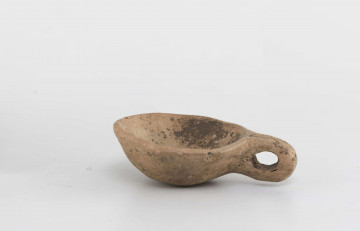
Sieve vessel
National Museum in Lublin
Part of the collection: Archaeological monuments of the Lublin region
This small clay vessel was found in Tarnoszyn (Tomaszów Poviat). It was made in the Bronze Age, i.e. about 3,000 years ago when the Lusatian culture developed in this area.
The structure of the vessel is very particular, such a shape is rare among the findings in our country. As one can see in the photos, the leg changes into the belly, and then separates into four, as like goblets, slightly opening outwards. The upper part of the belly is decorated with diagonal grooves in-between which there are groups of punctures. Due to the dimensions of the item, the height of which is just over 7 cm, and the diameter of the goblets less than 2 cm, the vessel fits in hand.
Where does this shape of the vessel come from?
At first glance, the item is similar to kernoses - vessels used in ancient Greece in context of the cult of Demeter - the protector of agriculture and fertility. Originally, kernos was made of clay, bronze or marble. A distinct feature of such a vessel is the arrangement of smaller goblets (or cups) around the perimeter, which are connected to the main vessel by channels.
Offerings to the goddess were placed in such goblets during religious ceremonies. There are ancient accounts where cereals, vegetables, fruits, as well as cookies, honey, wine and other gifts are described among the offerings.
Of course based on the found vessel we cannot confirm that there was a cult of the goddess Demeter in our lands. Most likely, the shape of the vessel turned out to be so attractive that it spread over a large area and could have had a completely different function than the original or was associated with some local deity.
Author / creator
Dimensions
cały obiekt: height: 7,3 cm, diameter: 5,8 cm
Object type
dish
Technique
firing
Material
clay
Creation / finding place
Owner
The National Museum in Lublin
Identification number
Location / status

National Museum in Lublin

National Museum in Lublin

National Museum in Lublin
DISCOVER this TOPIC
Museum of King Jan III's Palace at Wilanów
DISCOVER this PATH
Educational path